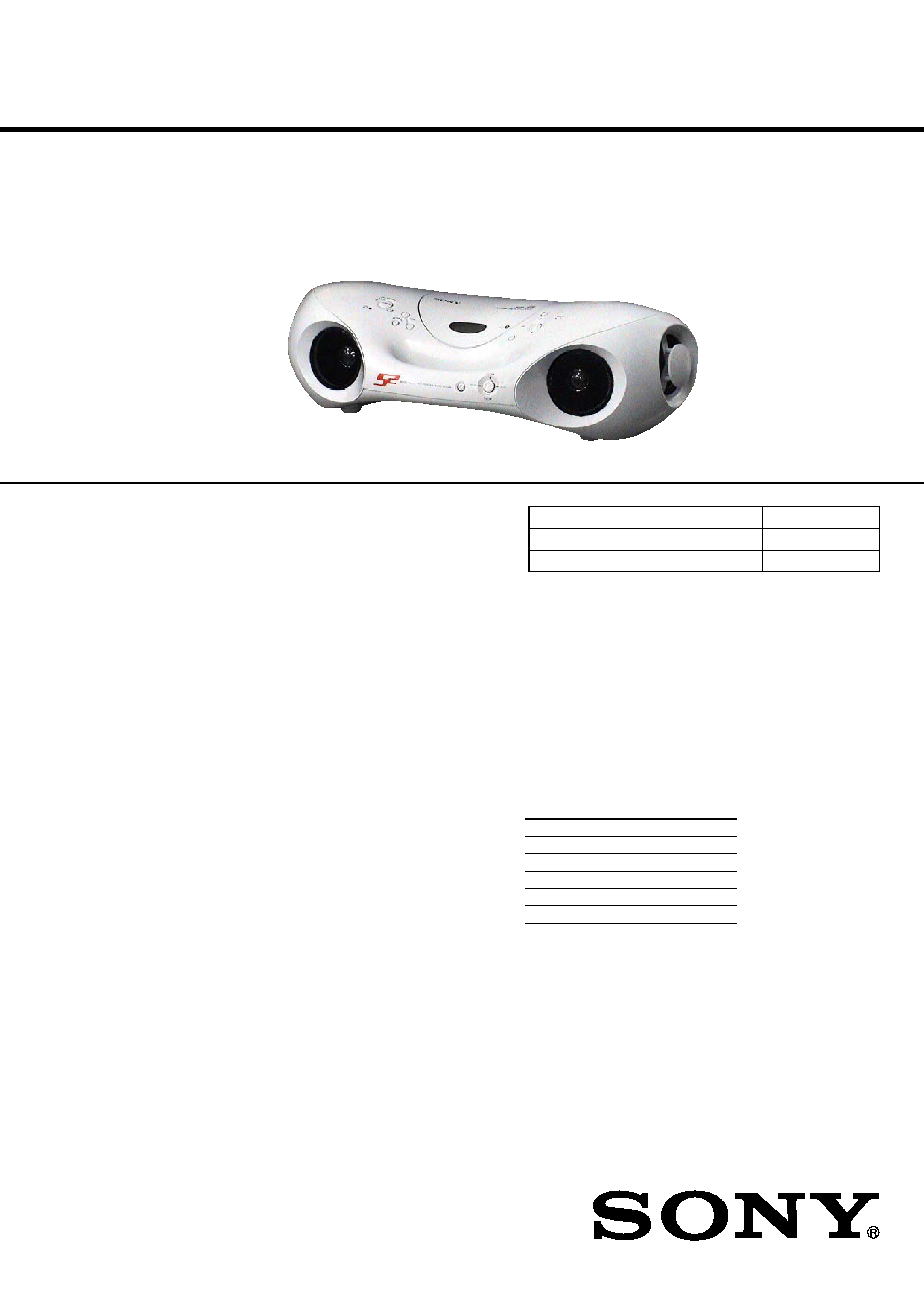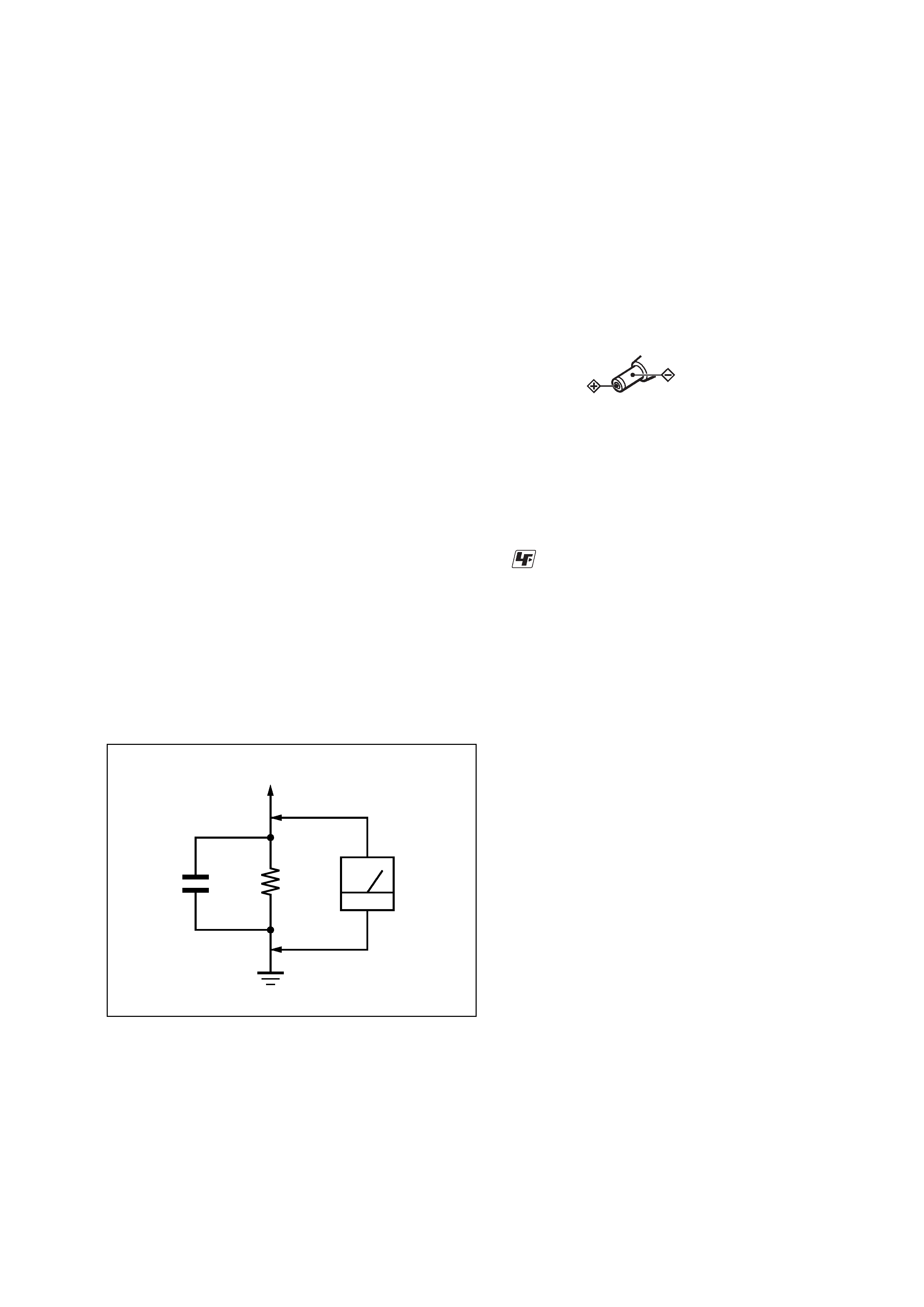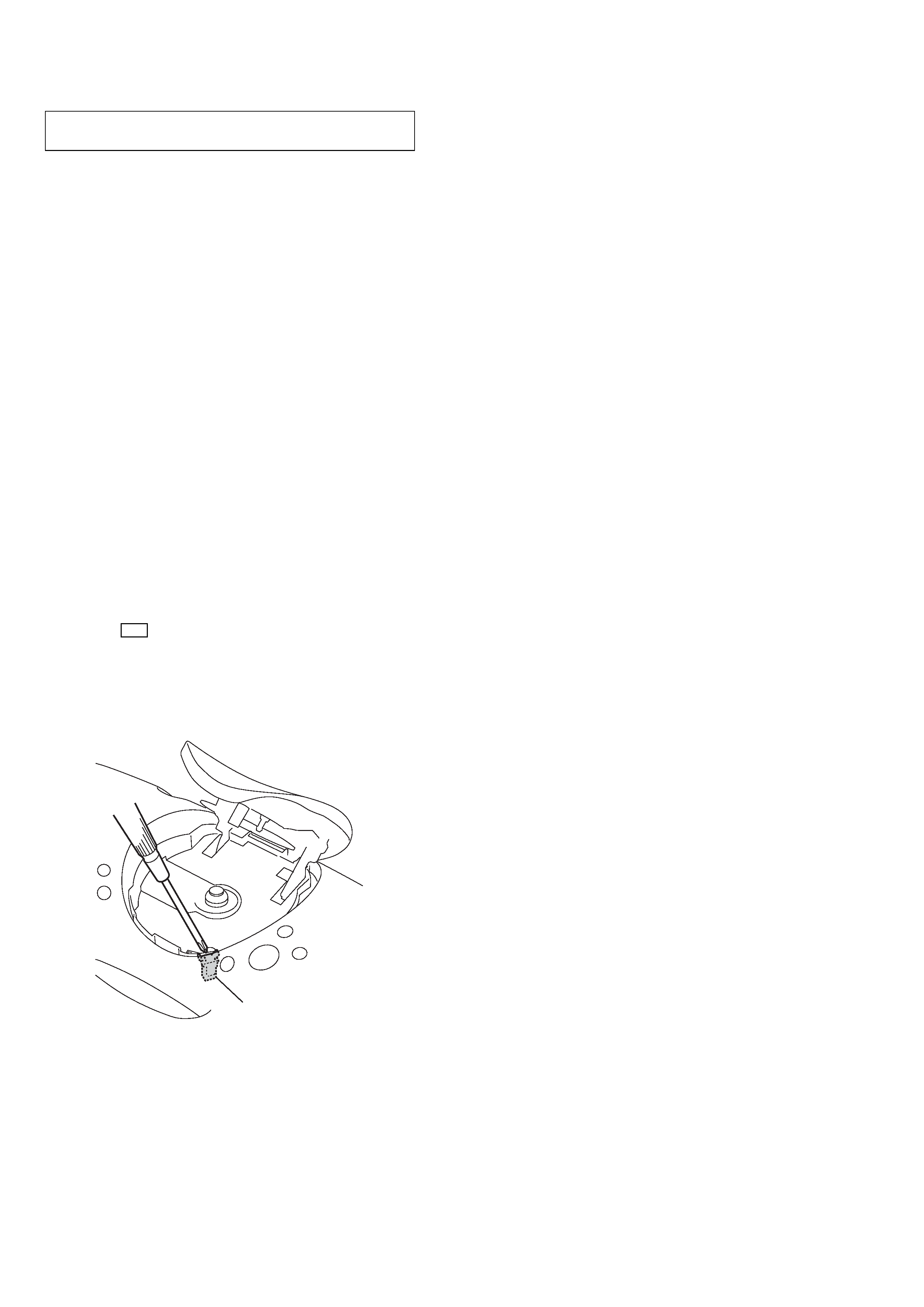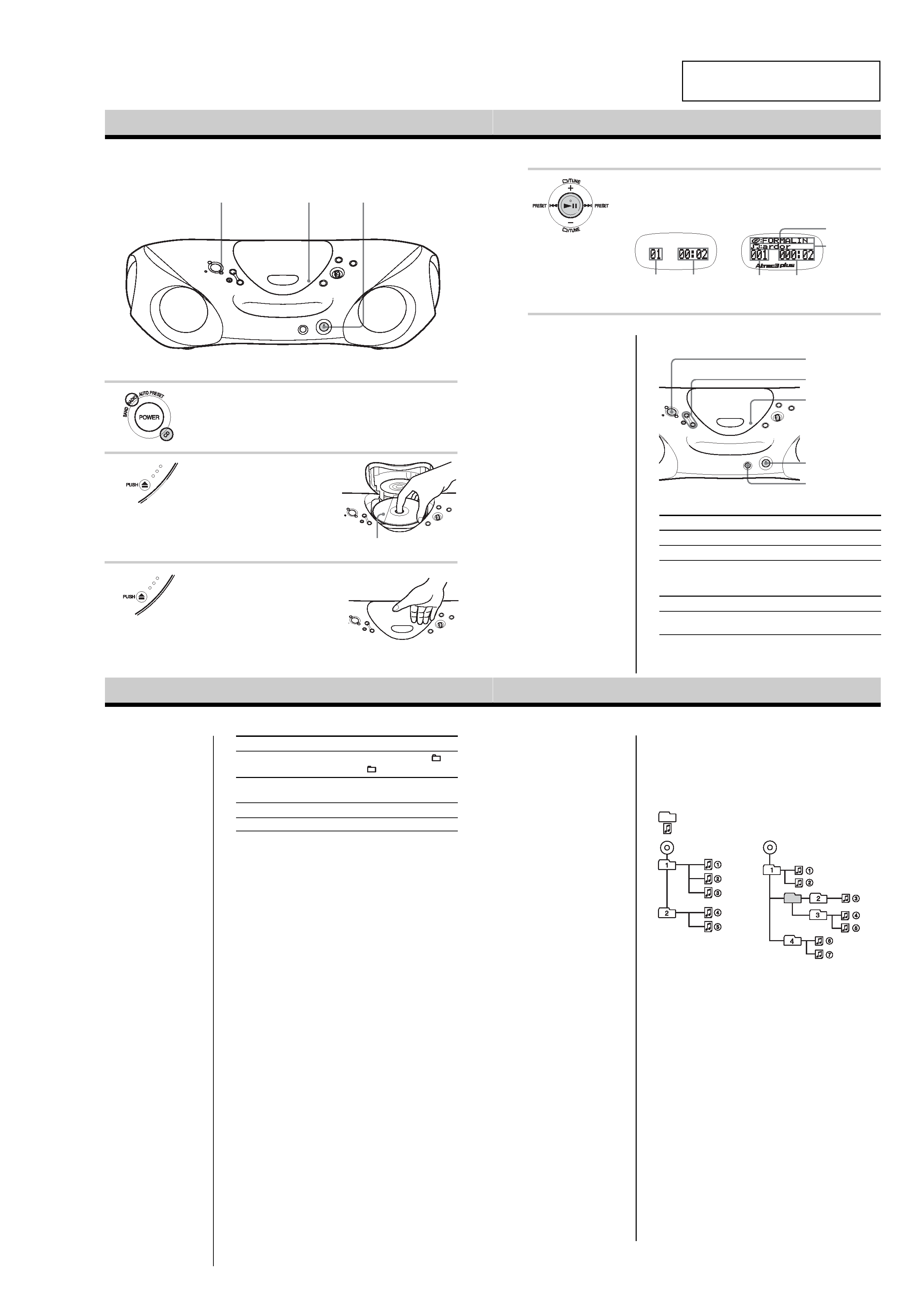
SERVICE MANUAL
PERSONAL AUDIO SYSTEM
US Model
Canadian Model
E Model
SPECIFICATIONS
ZS-XN30
Ver. 1.1 2004.12
9-877-632-02
Sony Corporation
2004L05-1
Personal Audio Company
© 2004.12
Published by Sony Engineering Corporation
Model Name Using Similar Mechanism
NEW
Optical Pick-up Block Name
KSM-213RAP
Optical Pick-up Name
KSS-213R
US and foreign patents licensed from Dolby Laboratories.
(US model only)
AUDIO POWER SPECIFICATIONS
POWER OUTPUT AND TOTAL HARMONIC
DISTORTION
With 3.2-ohm loads, both channels driven from
100 - 10,000 Hz; rated 1.7 W per channel-
minimum RMS power, with no more than 10 %
total harmonic distortion in AC operation.
Other Specifications
CD player section
System
Compact disc digital audio system
Laser diode properties
Material: GaAlAs
Wave length: 780 nm
Emission duration: Continuous
Laser output: Less than 44.6
µW
(This output is the value measured at a distance of about
200 mm from the objective lens surface on the optical
pick-up block with 7 mm aperture.)
Spindle speed
400 r/min (rpm) to 1 000 r/min (rpm) (CLV)
Number of channels
2
Frequency response
20 - 20 000 Hz +0/1 dB
Wow and flutter
Below measurable limit
Radio section
Frequency range
FM: 87.5 - 108 MHz
AM: 530 - 1 710 kHz
Antennas
FM: Telescopic antenna
AM: Built-in ferrite bar antenna
General
Speaker
Full range: 8 cm (3 1/4 in.) dia.,
3.2
, cone type (2)
Passive radiator: 8 cm (3 1/4 in.) dia. (2)
Output
Headphones jack (stereo minijack):
For 16 - 64
impedance headphones
Power output
2.3 W + 2.3 W (at 3.2
, 10 % harmonic
distortion)
Power requirements
DC IN 9V jack accepts:
Supplied AC power adaptor for use with 120 V AC,
60 Hz
9 V DC, 6 size C (R14) batteries
Battery life
CD playback
Sony R14P: approx. 2 h
Sony alkaline LR14: approx. 8 h
Radio reception
Sony R14P: approx. 23 h
Sony alkaline LR14: approx. 45 h
Dimensions
Approx. 511
× 154 × 244 mm (w/h/d)
(20 1/8
× 6 1/8 × 9 5/8 inches) (incl. projecting parts)
Mass
Approx. 3.2 kg (7 lb. 1 oz) (incl. batteries)
Supplied accessories
AC power adaptor (1)
CD-ROM (SonicStage 2.0) (1)
SonicStage 2.0 Installation/Operating Guide (1)
Design and specifications are subject to change without
notice.

2
ZS-XN30
TABLE OF CONTENTS
1.
SERVICING NOTES ..............................................
4
2.
GENERAL ..................................................................
5
3.
DISASSEMBLY
3-1. Disassembly Flow ...........................................................
7
3-2. Cabinet (Lower) ..............................................................
8
3-3. Main Chassis Section ......................................................
8
3-4. AUDIO Board, BATTERY Board ..................................
9
3-5. TUNER Board, CONTROL Board .................................
9
3-6. CD Block Section ............................................................ 10
3-7. CD Lid ............................................................................. 10
3-8. Cabinet Front (L)/(R) Assy ............................................. 11
3-9. Cabinet Front (L) Sub Assy ............................................ 11
3-10. Cabinet Front (R) Sub Assy ............................................ 12
4.
ELECTRICAL ADJUSTMENTS
Tuner Section ................................................................. 13
CD Section ..................................................................... 15
5.
DIAGRAMS
5-1. Block Diagram CD SERVO Section ...................... 16
5-2. Block Diagram TUNER Section ............................ 17
5-3. Block Diagram MAIN Section ............................... 18
5-4. Note for Printed Wiring Boards and
Schematic Diagrams ....................................................... 19
5-5. Printed Wiring Board CD Board ............................ 20
5-6. Schematic Diagram CD Board ............................... 21
5-7. Printed Wiring Board TUNER Board ..................... 22
5-8. Schematic Diagram TUNER Board ....................... 23
5-9. Printed Wiring Board CONTROL Board ............... 24
5-10. Schematic Diagram CONTROL Board .................. 25
5-11. Printed Wiring Boards PANEL Section ................. 26
5-12. Schematic Diagram PANEL Section ...................... 27
5-13. Printed Wiring Boards AUDIO Section ................. 28
5-14. Schematic Diagram AUDIO Section ...................... 29
6.
EXPLODED VIEWS
6-1. Cabinet (Lower) Section ................................................. 40
6-2. Cabinet Section-1 ............................................................ 41
6-3. Cabinet Section-2 ............................................................ 42
6-4. Cabinet (Upper) Section ................................................. 43
6-5. Main Chassis Section ...................................................... 44
6-6. CD Block Section ............................................................ 45
6-7. Optical Pick-up Section (KSM-213RAP) ...................... 46
7.
ELECTRICAL PARTS LIST .............................. 47
CAUTION
Use of controls or adjustments or performance of procedures
other than those specified herein may result in hazardous ra-
diation exposure.
This Compact Disc player is classified as a
CLASS 1 LASER product.
The CLASS 1 LASER PRODUCT label is located
at the bottom.

3
ZS-XN30
ATTENTION AU COMPOSANT AYANT RAPPORT
À LA SÉCURITÉ!
LES COMPOSANTS IDENTIFIÉS PAR UNE MARQUE 0
SUR LES DIAGRAMMES SCHÉMATIQUES ET LA LISTE
DES PIÈCES SONT CRITIQUES POUR LA SÉCURITÉ
DE FONCTIONNEMENT. NE REMPLACER CES COM-
POSANTS QUE PAR DES PIÈCES SONY DONT LES
NUMÉROS SONT DONNÉS DANS CE MANUEL OU
DANS LES SUPPLÉMENTS PUBLIÉS PAR SONY.
SAFETY-RELATED COMPONENT WARNING!!
COMPONENTS IDENTIFIED BY MARK 0 OR DOTTED
LINE WITH MARK 0 ON THE SCHEMATIC DIAGRAMS
AND IN THE PARTS LIST ARE CRITICAL TO SAFE
OPERATION. REPLACE THESE COMPONENTS WITH
SONY PARTS WHOSE PART NUMBERS APPEAR AS
SHOWN IN THIS MANUAL OR IN SUPPLEMENTS PUB-
LISHED BY SONY.
Notes on chip component replacement
· Never reuse a disconnected chip component.
· Notice that the minus side of a tantalum capacitor may be dam-
aged by heat.
Flexible Circuit Board Repairing
· Keep the temperature of the soldering iron around 270 °C dur-
ing repairing.
· Do not touch the soldering iron on the same conductor of the
circuit board (within 3 times).
· Be careful not to apply force on the conductor when soldering
or unsoldering.
SAFETY CHECK-OUT
After correcting the original service problem, perform the follow-
ing safety check before releasing the set to the customer:
Check the antenna terminals, metal trim, "metallized" knobs,
screws, and all other exposed metal parts for AC leakage.
Check leakage as described below.
LEAKAGE TEST
The AC leakage from any exposed metal part to earth ground and
from all exposed metal parts to any exposed metal part having a
return to chassis, must not exceed 0.5 mA (500 microamperes).
Leakage current can be measured by any one of three methods.
1. A commercial leakage tester, such as the Simpson 229 or RCA
WT-540A. Follow the manufacturers' instructions to use these
instruments.
2. A battery-operated AC milliammeter. The Data Precision 245
digital multimeter is suitable for this job.
3. Measuring the voltage drop across a resistor by means of a
VOM or battery-operated AC voltmeter. The "limit" indica-
tion is 0.75 V, so analog meters must have an accurate low-
voltage scale. The Simpson 250 and Sanwa SH-63Trd are ex-
amples of a passive VOM that is suitable. Nearly all battery
operated digital multimeters that have a 2 V AC range are suit-
able. (See Fig. A)
Fig. A.
Using an AC voltmeter to check AC leakage.
1.5 k
0.15
µF
AC
voltmeter
(0.75 V)
To Exposed Metal
Parts on Set
Earth Ground
About CD-Rs/CD-RWs
This CD player can play CD-Rs/CD-RWs
recorded in the ATRAC3plus/ATRAC3,
MP3 or CDDA* format, but playback
capability may vary depending on the quality
of the disc and the condition of the recording
device.
* CDDA is the abbreviation for Compact Disc
Digital Audio. It is a recording standard used for
the Audio CDs.
Note
Use only the supplied AC power adaptor. Do not
use any other AC power adaptor.
Po la rity o f the p lug
UNLEADED SOLDER
Boards requiring use of unleaded solder are printed with the lead-
free mark (LF) indicating the solder contains no lead.
(Caution: Some printed circuit boards may not come printed with
the lead free mark due to their particular size)
: LEAD FREE MARK
Unleaded solder has the following characteristics.
· Unleaded solder melts at a temperature about 40 °C higher than
ordinary solder.
Ordinary soldering irons can be used but the iron tip has to be
applied to the solder joint for a slightly longer time.
Soldering irons using a temperature regulator should be set to
about 350
°C.
Caution: The printed pattern (copper foil) may peel away if the
heated tip is applied for too long, so be careful!
· Strong viscosity
Unleaded solder is more viscou-s (sticky, less prone to flow)
than ordinary solder so use caution not to let solder bridges oc-
cur such as on IC pins, etc.
· Usable with ordinary solder
It is best to use only unleaded solder but unleaded solder may
also be added to ordinary solder.

4
ZS-XN30
SECTION 1
SERVICING NOTES
The laser diode in the optical pick-up block may suffer electro-
static break-down because of the potential difference generated
by the charged electrostatic load, etc. on clothing and the human
body.
During repair, pay attention to electrostatic break-down and also
use the procedure in the printed matter which is included in the
repair parts.
The flexible board is easily damaged and should be handled with
care.
NOTES ON LASER DIODE EMISSION CHECK
The laser beam on this model is concentrated so as to be focused
on the disc reflective surface by the objective lens in the optical
pick-up block. Therefore, when checking the laser diode emis-
sion, observe from more than 30 cm away from the objective lens.
LASER DIODE AND FOCUS SEARCH OPERATION
CHECK
During normal operation of the equipment, emission of the laser
diode is prohibited unless the upper lid is closed while turning ON
the S801. (push switch type)
The following checking method for the laser diode is operable.
· Method
Emission of the laser diode is visually checked.
1. Open the upper lid.
2. Push the S801 as shown in Fig.1.
Note: Do not push the detection lever strongly, or it may be bent or dam-
aged.
3. Press the u button.
4. Check the object lens for confirming normal emission of the
laser diode. If not emitting, there is a trouble in the automatic
power control circuit or the optical pick-up.
In this operation, the object lens will move up and down 2
times along with inward motion for the focus search.
NOTES ON HANDLING THE OPTICAL PICK-UP
BLOCK OR BASE UNIT
Fig.1 Method to push the S801
S801

5
ZS-XN30
SECTION 2
GENERAL
This section is extracted from
instruction manual.
Playing a CD
Connect the supplied AC power adaptor.
1
Press CD (direct power-on).
2
Press Z PUSH down to open the CD
compartment and place the CD on
the CD compartment.
Note
When opening/closing the CD
compartment, place the player on a level
surface and then press Z PUSH down.
3
Close the lid of the CD compartment.
With the label side up
1
4
2, 3
Basic Operations
Playing time
Track number
Playing time
File number
4
Press u.
The player plays all the tracks once.
* When playing an MP3 CD, MP3
appears in the display.
Display
Audio CD
5-way control key
u
POWER
VOL +, --
x
Use these buttons for a ddit iona l ope ra t ions
To
Do this
adjust the volume
Press VOL +*1, --.
stop playback
Press x.
pause playback
Press u*1.
Press the button again to resume play after
pause.
go to the next track
Push the 5-way control key toward >.
go back to the
Push the 5-way control key toward ..
previous track
*1 The button has a tactile dot.
Tip
Playback starts from the
point you last stopped
playing (Resume play).
During stop, the point to be
played is displayed.
To cancel the resume play
to start play from the
beginning of the first track,
press x in stop mode.
Group name
File name
ATRAC CD/MP3 CD*
Z PUSH
Note
Before playing an ATRAC
CD/MP3 CD, this player
reads all file and group
information on the CD.
Depending on the file
structure, it may take more
than a minute to read them.
During this time, Reading
is displayed.
To
Do this
select a group*2
Push the 5-way control key toward
+ to
go forward and
-- to go backward.
select a file*2
Push the 5-way control key toward > to
go forward and . to go backward.
remove the CD
Press Z PUSH*3.
turn on/off the player Press POWER.
*2 You can operate during play of ATRAC CDs/MP3 CDs.
*3 Once you open the CD compartment, the track to start play will
change to the beginning of the first track.
About ESP (Electronic Shock Protection)
func t ion
When a CD is playing, the ESP function is always
activated. The ESP function prevents the sound from
skipping by using a buffer memory that stores music data
for about 10 seconds.
The st ruc t ure of AT RAC CDs/M P3 CDs
ATRAC CDs/MP3 CDs consist of files and groups. A
file is equivalent to a track of an audio CD. A group
is a bundle of files and is equivalent to an album.
For MP3 CDs, this CD player recognizes an MP3 folder as
a group so that ATRAC CDs and MP3 CDs can be
operated in the same way.
Notes
¥ If ATRAC3plus/ATRAC3
files and MP3 files are
recorded on the same CD,
this CD player plays the
ATRAC3plus/ATRAC3
only.
¥ The playback capability of
this CD player may vary
depending on the quality of
the disc and the condition of
the recording device.
¥ Acceptable characters on
this CD player are as
follows:
--A to Z
--a to z
--0 to 9
--! " # $ % & ' ( ) * + , - . / :
; < = > ? @ [ \ ] ^ _ ` { | }
~
If you use other characters
on you computer by using
an software such as
SonicStage, they are
displayed as -- on this CD
player.
¥ On a disc that has
ATRAC3plus/ATRAC3/
MP3 files, do not save files
in other formats and do not
make unneccessary groups.
ATRAC CD
Pla ying orde r of AT RAC CDs a nd M P3 CDs
For ATRAC CDs, files are played in the order selected in
SonicStage.
For MP3 CDs, the playing order may differ depending on
the method used to record MP3 files on the disc. In the
following example, files are played in order of 1 to 7.
Notes on AT RAC CDs
¥ Maximum number of groups: 255
Maximum number of files: 999
¥ CD-Rs/CD-RWs recorded in the ATRAC3plus/ATRAC3 format
cannot be played on your computer.
Notes on MP3 CDs
¥ Maximum number of groups: 100
Maximum number of files: 400
Maximum directory level: 8
¥A group that does not include an MP3 file is skipped.
¥ Be sure to add the file extension mp3 to the file name.
However, if you add the file extension mp3 to a file other than
an MP3 file, the player will not be able to recognize the file
properly.
¥ This player can play bit rates of 16 to 320 kbps, and sampling
frequencies of 32/44.1/ 48 kHz. Variable Bit Rate (VBR) file
can also be played.
¥ To compress a source in an MP3 file, we recommend setting the
compression parameters to 44.1 kHz,
128 kbps, and
Constant Bit Rate.
¥ To record up to the maximum capacity, set the writing software
to halting of writing.
¥ To record to the maximum capacity at one time up on media that
has nothing recorded on it, set the writing software to Disc at
Once.
File
Group
MP3 CD
